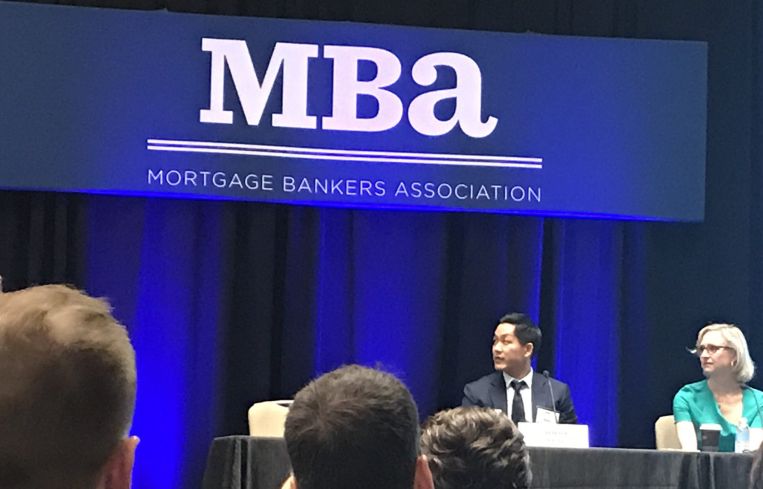Debt Funds Talk Overcrowding on Their Turf, the End of Quantitative Easing
By Cathy Cunningham February 15, 2018 12:59 pm
reprints
At the Evolution of Private Debt Funds panel at MBA’s CREF conference this week, moderator Jack Cohen, the CEO of Darkknight Ventures, injected some levity into the discussion in the form of some light-hearted pop quizzes.
Panelists were asked to describe the current alternative lending environment in three words or less. “Very competitive,” said Jimmy Yung, a managing director at Blackstone Real Estate Debt Strategies; “Seeing some cracks,” Greta Guggenheim, the CEO of TPG Real Estate Finance Trust, opined; “Too much capital,” said Tom MacManus, the president of A10 Capital.
Next, panelists were asked to define a debt fund’s role in terms that a even 12-year-old would understand. Yung was given a gold star by Cohen for offering the simple definition: “We give people money to buy properties and ask them to pay us back.”
A debt fund’s purpose was once viewed as bridging a lending gap in the market where traditional lenders couldn’t tread. But today, debt funds aren’t the alternative anymore, Yung said: “We’re building long-lasting mortgage finance businesses.”
In addition to offering more leverage, debt funds play a critical today in financing larger, complex transitional loans because of the flexibility they can offer with regard to future funding commitments, Guggenheim said.
But where there’s opportunity (and yield), there’s competition—and a lot of it. Debt funds aren’t only competing with more traditional capital sources on deals, they’re competing with each other, as an increasing number of new funds pop up in the already crowded space—many borne out of private equity funds unable to deploy capital in their current form.
But before you think of jumping on the bandwagon and starting your own debt fund, Guggenheim cautioned that, as a result of increased competition, “Yields have really gone down—it’s not nearly as attractive [a space] as it was.”
“It’s all about relationships,” Yung said of how Blackstone stays ahead of its competitors. “And we are really thoughtful about the real estate and can underwrite the whole loan. We have scale, speed and efficiency.”
Guggenheim and MacManus agreed that an important differentiator in standing out from the crowd is in having an asset management division. Several of the newer debt funds lack the infrastructure to service clients and handle requests, they said, with no division between a loan’s originator and asset manager.
When the conversation turned to recent unexpected events in the market, Guggenheim said that the Federal Reserve’s call to end quantitative easing at the end of last year was a big surprise.
“[Quantitative easing] has kept asset prices attractive,” Guggenheim said. “Without it, the opposite will occur.” She added that the prospect of a higher interest interest rate is now “pretty high, as we’ve never had quantitative easing like this.”
As for potential future surprises, Guggenheim said it’s tough to predict what’s next in this real estate cycle—her reasoning being that, to make a prediction, you need to rely on historical information, and as the past cycle has been an anomaly, there is no historical data to form that prediction. However, “I do believe we will see interest rates rise with a negative effect on asset values,” she said.
TPG has been stressing its floating-rate loan production with higher interest rates in preparation for this, Guggenheim said.
Borrowers are also concerned about where we are in the economic cycle and being more savvy about leverage and requiring more flexibility around their business plans as a result, Guggenheim said. Whereas a 3-1-1 structure may be typical in bridge loans on transitional assets, borrowers are now requesting that three-year base term to be extended to four or five years.
Other areas of concern for short- to medium-term market dislocations addressed by the panel include geopolitical risk—Yung pointed to growing tensions with North Korea and the continued effects of Brexit as being on Blackstone’s radar—and the Class-A multifamily sector. “There’s just way too much capital coming in,” MacManus said.


